Malankara Orthodox Syrian Church
| Malankara Orthodox Syrian Church | |
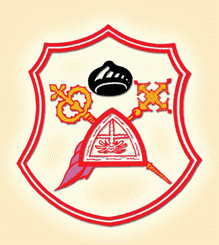 Catholicate Emblem |
|
| Founder | St. Thomas the Apostle |
| Independence | Apostolic Era |
| Recognition | Oriental Orthodox |
| Primate | Baselios Marthoma Didymos I |
| Headquarters | Kottayam, Kerala, India |
| Territory | Universal |
| Possessions | United Arab Emirates, United States, Canada, Great Britain, Ireland, South Africa, Kuwait, Malaysia, New Zealand, Germany, Switzerland, Oman, Qatar, Bahrain, Singapore and Australia, |
| Language | Malayalam, English, Hindi, Konkani, Syriac |
| Adherents | 3 million[1] |
| Website | malankaraorthodoxchurch.in & orthodoxchurch.in |
The Malankara Orthodox Syrian Church, also known as the Indian Orthodox Church, is an autocephalous Oriental Orthodox church centred in the Indian state of Kerala. It is one of the churches of India's Saint Thomas Christian community, which traces its origins to the evangelical activity of Thomas the Apostle in the 1st century. The church is headed by the autonomous Catholicos of the East, but maintains some ties with the Syriac Orthodox Church and its primate, the Syriac Orthodox Patriarch of Antioch.
Historically, the Saint Thomas Christians were united in leadership and liturgy, and were part of the Church of the East centred in Persia.[2][3] From the 16th century the Portuguese Jesuits attempted to forcefully bring the community fully into the Latin Rite of the Catholic Church. Resentment of these measures led the majority of the community to join the archdeacon, Thomas, in swearing never to submit to the Portuguese in the Coonan Cross Oath in 1653. The part of the church that followed Thomas is known as the Malankara Church.
Following the arrival of the Bishop Gregorios Abdul Jaleel of Jerusalem, Archdeacon Thomas forged a relationship with the Syriac Orthodox Church and gradually adopted West Syrian liturgy and practices. Over time, however, relations soured between the Syriac Orthodox Patriarchs and the local hierarchy, particularly after Patriarch Ignatius Peter IV (reigned 1872—1894) began demanding registered deeds for the transfer of properties. In 1912, a synod led by the Patriarch Ignatius Abdul Masih II, who had been controversially deposed by the Ottoman government,[4][5] consecrated Evanios as Catholicos of the East, under the name Baselios Paulose I. The faction that supported Baselios Paulose became what is now the Malankara Orthodox Syrian Church, while those who supported the Patriarch became the Jacobite Syrian Christian Church. The two groups were briefly reunited between 1958 and 1975, but attempts by church leaders and two Supreme Court decisions were unable to resolve the contention, and the two churches operate independently today.
The church is theologically and traditional a part of the Oriental Orthodox communion of churches. The Indian Orthodox Church accepts the Alexandrian Christology, as does the Coptic Orthodox Church and follows west syrian rite liturgy.
Contents |
History
First 17 centuries
| Part of a series on |
| Christianity in India |
|---|
 |
| Background |
| Nasrani St. Thomas Christians
Ancient Crosses of India(history) Synod of Diamper Coonan Cross Oath |
| People |
| St. Thomas the Apostle St. Francis Xavier St. Gonsalo Garcia Devasahayam Pillai St. Alphonsa Muttathupadam Thomas of Cana Mother Teresa Mar Augustine Kandathil Mar Sapor and Prodh Marthoma Metrans St. Gregorios of Parumala St. Baselios Eldho Fr. Kuriakose Elias Chavara St. Geevarghese
William CareyMar Dionysius |
| Churches |
| Andhra Evangelical Lutheran Chaldean Syrian Church of North India Church of South India Jacobite Syrian Latin Catholic Malankara Malankara Orthodox Syrian Malabar Independent Syrian Mar Thoma Presbyterian St. Thomas Evangelical Syro-Malabar Catholic Syro-Malankara Catholic The_Pentecostal_Mission |
| Indian Christianity portal |
Thomas the Apostle is credited by tradition for founding the Indian Church in 52 A.D.[3] This Nasrani faith had many similarities to Judaism, and, owing to the heritage of the Nasrani people, developed contacts with the Non-Chalcedonian religious authorities of Edessa, Mesopotamia.
The local church maintained its autonomous character under its local leader. When the Portuguese established themselves in India in the 16th Century, they found the Church in Kerala as an administratively independent community. Following the arrival of Vasco de Gama in 1498, the Portuguese came to South India and established their political power there. They brought missionaries to carry out evangelistic work in order to establish churches in communion with Rome under the Portuguese patronage.
These missionaries were eager to bring the Indian Church under the Pope's control. They succeeded in their efforts in 1599 with the Synod of Diamper.The representatives of various parishes who attended the assembly were forced by Portuguese authorities to accept the Papal authority. Following the synod, the Indian Church was governed by Portuguese prelates. They were generally unwilling to respect the integrity of the local church. This resulted in disaffection which led to a general revolt in 1653 known as The Coonan Cross Oath. This demanded administrative autonomy for the local church. Since it had no bishop, it faced serious difficulties. It appealed to several eastern Christian churches for help. The Antiochene Syrian Patriarch responded and sent metropolitan Mar Gregorios of Jerusalem to India in 1665. He confirmed Marthoma I as the bishop and worked together with him to organize the Church.
Until 1599, it depended on the Assyrian (Persian) Church for prelates to ordain its priests.[6]
Administration
Archdeacon or Arkadayakon in Malayalam was “the prince and head of the Christians of Saint Thomas” and had such titles as Archdeacon and Gate of All India, Governor of India. He was the temporal ruler and administrator of the Saint Thomas Christians of Kerala. The Archdeacon was more of a secular ruler, having sanction of local Hindu rulers and he is said to have carried around a small army of few hundred Syrian Christian soldiers.[7]
The earliest historical documents that shows the existence of Archdeacons is around the year AD 800. The Nestorian Patriarch Timothy I (780-826) wrote to the Archdeacon ( Arken), the Head of the Faithful in India, about the right norms to be followed in the ordination of the priests, bishops, metropolitans and patriarch.[8]
After the arrival of the Portuguese, the records next mention Archdeacons. The following is a known list of Archdeacons in Malankara:[9]
- Nestorian Patriarch Timothy I calls Archdeacon (Arken), head of faithful of India c.780-826
- Metropolitan Mar John appoints George Pakalomattam (Ittikuriath) as Archdeacon 1502
- Followed by Archdeacons Jacob and Alexander according to tradition (Dates unknown)
- Archdeacon George of Christ (Mentioned in 1552 documents onwards) c.1552-1585
- Archdeacon John c.1585-1591
- Archdeacon Jacob appointed by Mar Simon c. 1584-1596
- Archdeacon George of the Cross appointed by Archbishop Mar Abraham 1593-1640
- Archdeacon Thomas appointed by elders of Malankara. In 1653, after the Coonan Cross Oath, Archdeacon Thomas was consecrated as Bishop Mar Thoma I, thus the role was changed and his line continued until Mar Thoma VIII in 1815 among the Malankara Orthodox Syrians[10].
Reign of the Marthoma Metropolitans (1653-1816)
In 1653, following the Coonen Cross Oath the Malankara Church felt the need to have an indigenous bishop. The parish elders (Idavaka Mooppens) of the Church met together and elected Archdeacon Thomas as their leader. This was followed by a general meeting at Allangad on 22 May 1653 where Archdeacon Thomas was elevated to the status of bishop with the title Mar Thoma I by laying on of hands of 12 leading priests of the Church.[11]
The other section of Christians under the Roman Catholic Church did not consider Mar Thoma I as a bishop due to the nature of his ordination and many of the revolters returned to the Roman Catholic Church between 1653 and 1665 as a result of the proselytization efforts of the Carmelite missionaries send by Rome.[12]. To confirm this rank, the Metropolitan and leaders of the Church together wrote letters to the patriarchs of Alexandria and Antioch to send a higher authority.[13] Mar Gregorios Abdul Jaleel, the Syriac Orthodox Patriarch of Jerusalem arrived in 1665 and regularised the ordination of Mar Thoma I.[14] This started the reign of the Marthoma Metropolitans of Pakalomattom family in Malankara.
- Mar Thoma I (1653–1670)- In 1653, Kuravilangad Parampil Thomas of Pakalomattam family was consecrated with the title Marthoma I by the elders of the Malankara church. He was also the Archdeacon of the time, the leader of the entire Saint Thomas Christians.In 1665 his ordination was regularised by the Syriac Orthodox Patriarch Mar Gregorios of Jerusalem. Marthoma I survived a number of assassination attempts. He died on 25 April 1670 and was interred in Angamaly Martha Mariam Church.[15]
- Mar Thoma II (1670–1686)- Before his demise in 1670, Mar Thoma I ordained his nephew as Mar Thoma II. According to a local tradition once the people of Niranam were suffering from severe drought and they appealed to Mar Thoma II for his special prayers. They believe that as a result of his prayers the village received plenty of showers. Mar Thoma II led the church for 16 years and died in 1686. His mortal remains were entombed in the St.Marys Orthodox Church,Niranam and every year his memorial day is celebrated on 16 April.[16] During his time Eldho Mor Baselios & Hidayathullah Mar Ivanios from Syria visited Malankara.[17]

- Mar Thoma III (1686–1688)- Consecrated by Mar Ivanios Hidayathullah (from Antioch). He died on 21 April 1688. He was buried at St. Thomas Orthodox Cathedral, Kadampanad, Adoor.
- Mar Thoma IV(1688–1728)- Consecrated by Mar Ivanios Hidayathullah. He ruled the Church for four decades. The East Syrian Catholicos-Patriarch of Babylon, hearing of members lost to the Roman Catholics, sent Mar Gabriel to Kerala to try to reclaim them.
It was important for Mar Thoma IV to monitor this bishop doctrinally and administratively. In confronting Mar Gabriel however, Marthoma IV found himself incompetent. He sent several appeals to the West Syrian Patriarch asking for help. But no reply or help came. He died on 24 March 1728 and is entombed at St.Mary’s Orthodox Church, Kandanadu.[18]
- Mar Thoma V (1728–1765)– Consecrated by Marthoma IV. In 1752 when Mar Baselios and Mar Gregorios came to Malankara, they insisted that he should receive their Ordination but he refused to comply fearing Antiochean domination.[13] Not only that, he concecrated his successor Mar Thoma VI without any assistance from foreign bishops thus severing all allegiance to foreign bishops.Until Mar Thoma V,Malankara Church followed almost entirely East Syriac language, liturgy and practices. He died on 8 May 1765 and was buried at St.Marys Orthodox Church, Niranam.
- Mar Thoma VI (1765–1808)- (1765–1808) Consecrated by Marthoma V. On June 1770, to avoid a split in the Church, he accepted re-consecration and the title Dionysius from Antiochan bishops.[15] He also agreed with Mar Ivanios the visiting West Syrian bishop to follow in his Church certain traditions of the West Syrian Church along with the prevalent East Syrian traditions. The invasions of Tippu Sultan and devastation of many Christians and churches from Koodungallur to Kunnamkulam and forced conversions of Thomas Christians to Islam happened in this period.[18]
Mar Dionysius(Marthoma VI) was captured by Thachil Matthoo Tharakan a prominent Roman Catholic St. Thomas Christian and forced to conduct a Latin Catholic mass. But he escaped because of a Hindu revolt led by Velu Thampi Dalawa.[19] Died on 8 April 1808 and laid to rest at St. Mary’s Orthodox Cathedral, Puthencavu.
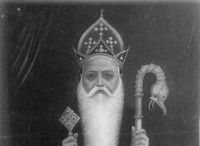
- Mar Thoma VII(1808–1809)- Consecrated by Marthoma VI in 1796. Unfortunately he had a very short span of life as metropolitan. The only event worth recording are the deposit of the Trust Fund money with the East India Company and withdrawal of the interest thereon for the first time.[18] Marthoma died on 4 July 1809 and was interred at Kolencherry St. Peter's and St. Pauls Orthodox Church.
- Mar Thoma VIII(1809–1816)- Consecrated on 2 July 1809 by Marthoma VII. During his time Orthodox Pazhaya Seminary or "Old Syrian Seminary" was opened and modern education began in Kerala. Marthoma died on 26 January 1816 and was interred at St. Mary’s Orthodox Cathedral, Puthencavu .[15] The establishment of Seminary and the rise of Pulikootil Joseph Ramban who was in charge of it weakened the prestige and power of the Mar Thoma considerably.
- Mar Thoma IX(1816–1817)- Consecrated by Marthoma VIII without the consent of the people. So he retired to Kadamattom Church and spent the rest of his days there.[15]
Until Marthoma IX, all Metropolitans came from the Pakalomattom family. The rise of Pulikottil Joseph Ramban changed this and the people identified him as their new leader. With him the tradition of Marthoma Metrans from Pakalomattom family came to an end.
- Mar Thoma X (Malankara Metropolitan) (1816-1816)- Also known as Pulikottil Joseph Mar Dionysius, was consecrated by Mar Philoxenos II, of the Malabar Independent Syrian Church (Thozhiyoor Sabha). He died on 25 November 1816 and was buried at Seminary Church.
The new bishops after Marthoma IX came from different families and they came to be known more popularly with the title Malankara Metropolitans rather than as Mar Thoma. Malankara Metropolitans started to be recognised by the secular rulers of Travancore and Cochin kingdoms, by a Royal Proclamation.[15] Nevertheless the title Marthoma continues to be used by the Catholicos of the Indian Orthodox Church.[20]
19th century
In 1795 the British captured Malabar, Kerala. In 1806, the Rev. Claudius Buchanan, an Anglican priest, visited the ancient Church of St.Thomas in India. In March 1815, Malankara Church opened a Seminary at Kottayam and in the next year, Anglican missionaries arrived to join this institution.[21][22] Soon, however, the missionaries began to impose Protestant doctrines on the seminarians. As a result the Malankara church discontinued the association.
This eventually gave rise to the division of the community into three bodies.
-
- One of them set out to bring about major reforms in the liturgy and practices of the Church, but failed. After about half a century of conflict within the Church, this body withdrew, and organized itself as the Mar Thoma Church.
- A smaller body of the Malankara Church opted to join with the missionaries and be absorbed into the Anglican Church.
- A large majority of the community continued in the Malankara Orthodox Church without accepting the reforms.[23]
The London Missionary Service was active in India. Bishop Norton inaugurated the first Anglican Church in Kerala at Thalavady in the house of one Itty Matthan Panickar. This church was later known as Church Missionary Society and after Indian Independence it became the Church of South India.
20th century
In 1912, the Catholicate of the East was revived in India. The Malankara Orthodox Church wanted to retain its autocephalous nature. It appealed to Patriarch Ignatius Abdul Masiha II of the Syriac Orthodox Church, who ordained Murimattathil Paulose Mar Ivanios as Baseliose Paulose, Catholicos of the East. The ceremony was held at St. Mary's Church, Niranam in 1912.[24]
Hierarchy, distribution and doctrine
The spiritual regional head of the church is the Catholicos of the East and the temporal head over the church assets is Malankara Metropolitan. Since 1934, both the titles vest in one person. The official title of the head of the Church is the "Catholicos of the East and the Malankara Metropolitan". The present Catholicos of the East and Malankara Metropolitan is Baselios Marthoma Didymos I, who was enthroned on 31 October 2005, at Parumala Church by the Holy Synod. Didymos I is the 111th Catholicos of the East in the lineage of Apostle Thomas; 6th Catholicos after its re-instatement in India and 19th Malankara Metropolitan.
The church accepts only the first three Ecumenical Synods like all other Oriental Orthodox Churches.
The church uses the liturgy of Saint James, as does its sister church, the Syrian Orthodox Church of Antioch. The Church in India was connected to the Church of East through the Catholicos of the East, existed in Edessa, Selucia, Tigris and Mosul in various intervals. Today the Church conducts liturgy in West Syriac, Malayalam, Hindi, and English.
The church has theological seminaries at Kottayam and Nagpur. The Church has dioceses and churches in most parts of India as well as in the United States, Canada, United Kingdom, Western Europe, Persian Gulf nations, Malaysia, Singapore, Australia and New Zealand.
The name, Malankara Orthodox Church, refers to St.Thomas Christians of India, that come under Catholicate of the East whose Supreme Head is His Holiness The Catholicos of the East and Malankara Metropolitan,with headquarters at Devalokam, Kottayam, Kerala, India.
Liturgy
Since the 17th century, the Malankara Orthodox Church uses the Syrian Orthodox Liturgy, which belongs to the Antiochene liturgical tradition. The East Syrian (Persian), Byzantine, Armenian, Georgian, Maronite liturgies also belong to the same liturgical family. In the first half of the fifth century, the Antiochene Church adopted the anaphora of Jerusalem, known under the name of St James, the disciple. In the fourth and the fifth centuries, the liturgical language of Jerusalem and Antioch was Greek. Therefore, the original form of St James liturgy was composed in Greek.
Following the Council of Chalcedon (451), the Eastern Church was divided into two, one group accepting the council and the other opposing it. Both groups continued to use the Greek version of St James. The Byzantine emperor Justin (518-527) expelled the Non-Chalcedonians from Antioch and they took refuge in the Syriac speaking Mesopotamia on the Roman-Persian Border (modern Eastern Syria, Iraq and South East Turkey). Gradually, the Antiochene liturgical rites were translated into Syriac. New elements such as Syriac hymns were introduced into it.
Mar Gregorios of Jerusalem came to Malankara in 1665 and introduced Syrian Orthodox liturgical rites. The most striking characteristic of the Antiochene liturgy is the large number of anaphoras (Order of the celebration of the Eucharist). About 80 are known and about a dozen are used in India. All of them have been composed following the model of Liturgy of St James.[25]
Catholicate


The word "Catholicos" means "The General Head". It can be considered as equivalent to "Universal Bishop". There were only three ranks of priesthood in the early Church: Episcopos (Bishop), Priest, and Deacon. By the end of the third century certain bishops of certain important cities in the Roman empire gained pre-eminence over other bishops and they came to be known as Metropolitans. The Ecumenical councils of the fourth century recognized the supreme authority of these Metropolitans. By the fifth century, the Bishops in major cities like Rome, Constantinople, Alexandria, Antioch etc. gained control over the churches in the surrounding cities. Gradually they became the heads of each independent regional church and were called Patriarch which means common father. The same rank in the Churches outside the Roman Empire was called Catholicos. There were three ancient Catholicates in the Church before the fifth century. They were the Catholicate of the East, the Catholicate of Armenia and the Catholicate of Georgia. None of these ranks and titles are the monopoly of any church. Any Apostolic and national church has the authority to declare and call its head, Catholicos, Pope, or Patriarch.
St.Thomas established the church in India and is recognized as its first Head or Catholicos.
The reign of the Archdeacons started from the fourth century and lasted until the sixteenth century. The third stage started when the archdeacon was elevated to the position of a Bishop by the community with the name Marthoma I in 1653. Since then the head of the community was the Marthoma Metrans and later the position was developed to Malankara Metropolitan with more recognition.
In 1912, the Catholicate of the East was relocated to India, and Baselios Paulose I was seated on the Honorary Apostolic Throne of St.Thomas as the Catholicos of the East.

The Headquarters of the Indian Orthodox Church, named Devalokam is located at Kottayam, in Kerala. It is the official headquarters of the Catholicos Of The East who reigns on the Honorary Throne of St. Thomas, the Apostle, and was established on 31 December 1951.
The new Aramana which was built in 1961 was inaugurated by the visiting Armenian Catholicos Vazgen I.
The mortal remains of Baselious Geevarghese II, Baselious Augen I Baselious Marthoma Mathews I, and Dr. Thomas Mar Makarios Great Metropolitan of the West are entombed in the Catholicate Chapel. A portion of the holy relics of St. Thomas, the Apostle of India and Founder of the Church, is also kept in the chapel.
List of Catholicos
The Catholicos lineage starts from the Apostle Thomas, continuing with the bishops of Edessa and Archbishops in Selucia-Ctesiphon. In 410 AD, Isaac first used the title Catholicos. Since then, the Catholicos has claimed jurisdiction over all Christians of the East outside the Roman Empire.
This Catholicate resided in Persia until the end of the 19th century. In 1912 , the senior Patriarch of the Syriac Orthodox Church of Antioch [26] relocated the Catholicate to India. Catholicos Didymos I is the 111th Catholicos sitting on the throne of Saint Thomas. The Orthodox Catholicos is known also known as Maphrian to distinguish this church from the schismatic lineage formed in the latter half of the 5th century due to Nestorian influence.
To see the lineage of Catholicos: List of Catholicos of the East
- Baselios Paulose I (1912–1914) (Catholicos of the East)
- Baselios Geevarghese I (1925–1928) (Catholicos of the East)
- Baselios Geevarghese II (Catholicos of the East, 1929-1964 & Malankara Metropolitan, 1934–1964)
- Baselios Augen I (1964–1975) (Catholicos of the East & Malankara Metropolitan)
- Baselios Mar Thoma Mathews I (1975–1991) (Catholicos of the East & Malankara Metropolitan)
- Baselios Mar Thoma Mathews II (1991–2005) (Catholicos of the East & Malankara Metropolitan)
- Baselios Thoma Didymos I (2005–present) (Catholicos of the East & Malankara Metropolitan)

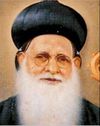
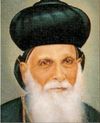
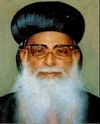
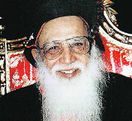
Saints of the Church

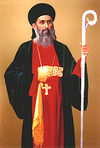
- Parumala Thirumeni (Gheevarghese Mor Gregorious) (Declared by the Holy Synod, in 1947, by Catholicos Baselios Gheevarghese II)
- Eldho Mor Baselios of Kothamangalam (Declared by the Holy Synod, in 1947, by Catholicos Baselios Gheevarghese II)
- Geevarghese Mar Dionysius of Vattasseril (Declared by the Holy Synod, in 2003 by Catholicos Baselios Marthoma Mathews II)
Current Metropolitans
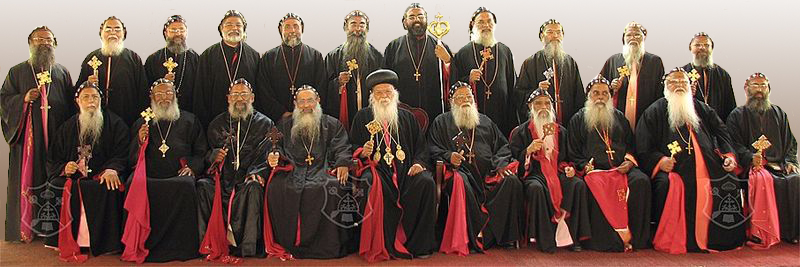

- Baselios Marthoma Didymos I (Catholicos of the East and Malankara Metropolitan)
- Paulose Milithios (Catholicos Designate)
- Dr. Geevarghese Osthathios
- Mathews Barnabas
- Geevarghese Ivanios
- Dr. Thomas Athanasius
- Dr. Yuhanon Milithios
- Kuriakose Cleemis
- Zachariah Anthonios
- Dr. Mathews Severius
- Job Philoxenos
- Geevarghese Coorilos
- Paulose Pachomius
- Dr. Yakoob Irenaeus
- Zachariah Nicholovos
- Dr. Gabriel Mar Gregorios
- Dr. Zachariah Theophilos
- Dr. Yuhanon Chrysostomos
- Yuhanon Policarpos
- Mathews Theodosius
- Joseph Dionysius
- Abraham Ephiphanios
- Dr. Mathews Timothios
- Alexios Eusebios
- Dr. Yuhanon Dioscoros
- Dr. Youhanon Dimitrios
- Dr. Yuhanon Theodoros
- Yakob Elias
- Joshua Nicodemus
- Dr. Zachariah Aprem
- Dr. Geevarghese Julius
- Dr. Abraham Seraphim
Theological seminaries

- Orthodox Pazhaya Seminary(Old Syrian Seminary), Kottayam
- Nagpur St. Thomas Orthodox Theological Seminary (St.Thomas Theological Seminary, Nagpur)
Ecumenical relations
The Malankara Orthodox Syrian Church takes an active role in various ecumenical activities at national and international levels. It was a founding member of the World Council of Churches.[27]
Various theologians were involved in negotiations between the Oriental Orthodox and the Byzantine churches. The Indian Orthodox Church participated in the Ecumenical Council of Oriental Orthodox Churches held in Addis Ababa, in 1965.
Other organizations to which the church belongs are
- Faith and Order Commission
- Christian Conference of Asia.
- Global Christian Forum
Monasteries of the Church
- Vallikkattu Dayara, Vakathanam
- St.Thomas Dayara, Bhilai
- Mount Tabor Dayara, Pathanapuram
- Mar Kuriakose Dayara, Pampady
- Bethany Ashram, Perunad
- Christushishiya Ashram (Thadakam), Coimbatore
- Mar Kuriakose Ashram, Mylapra
- Mar Basil Dayara, Pathanamthitta
- St.George Dayara, Othara
- St.Pauls Ashram, Puthuppady
- Bethlehem Ashram, Chengamanad
- Chayalode Ashram, Pathanmthitta
- Holy Trinity Ashram, Ranni
- Mar Baselios Ashram, Njaliakuzhy
- Bethel Ashram, Kuttikonam
- Calvary Ashram, Pattazhi
- St.Thomas Ashram, Sooranad
- Mount Carmel Ashram, Kallada
- St.Thomas Ashram, Attapadi
- St.Thomas Dayara, Vettikal
- Thrikkunnathu Seminary, Aluva (Head Quarters of Angamali Diocese)
- Mount Horeb Sasthamcotta (Tomb of Baselious Marthoma Mathews II)
Pilgrim sites
Founded by St.Thomas

- St.Mary's Church, Niranam[28]
- Thiruvithancode church
Tomb Churches
- St.Peter's & St.Paul's Syrian Orthodox Church, Parumala[29]
- Pampady Dayara
- Thevalakkara Mar Abo church [30]
- Kallada Valiyapalli
- Relics of Julius Mar Alvares, St. Marys Orthodox Church, Panjim, Goa
- St. Marys Orthodox Cathedral,Puthencavu
Churches with Historical Importance
- Mulanthuruthy Marthoman Cathedral
- Kottayam Cheriapally[31]
- Pampakuda Cheriapally (St.Thomas Church)
- Kallooppara St. Marys Orthodox Church [32]
- Vakathanam Vallikkattu Syrian Dayro
- Paliyekkara Palli
- Kadeesa Syrian Church ,Kollam
- Kadamattom Church
- Puthupally Palli[33]
- Coonan Cross Oath Memorial Holy Cross, St. George Orthodox Church, Mattancherry
- St. Mary's Orthodox Church Thevelakara [34]
Dioceses
| Angamaly Diocese | Chengannur Diocese | Idukki Diocese | Kandanad East Diocese |
| Kandanad West Diocese | Kollam Diocese | Kunnamkulam Diocese | Kottayam Diocese |
| Malabar Diocese | Mavelikara Diocese | Niranam Diocese | Sulthan Bathery Diocese |
| Thumpamon Diocese | Trichur Diocese | Trivandrum Diocese | Ahamedabad Diocese |
| Bangalore Diocese | Delhi Diocese | Kolkata Diocese | Madras Diocese |
| Mumbai Diocese | North East America | South West America | UK Europe & Africa |
| Kottayam Central Diocese |
See also
- Brahmavar (Goan) Orthodox Church
- List of Orthodox Churches
- List of Catholicos of the East
Notes
- ↑ [1] from official website
- ↑ Frykenberg, p. 93.
- ↑ Wilmshurst, EOCE, 343
- ↑ Vadakkekara, p. 95.
- ↑ Tamcke, p. 214.
- ↑ Page 618, Sabha Vijnanakosham (Church Encyclopaedia)
- ↑ Page 55, Malankara Nasranikalude Jathiaulkrishtiyavum Rajyasevanathalparathayum
- ↑ Page 121, Ibn at- Taiyib II
- ↑ The list given in ” The Archdeacon of All India” by Dr. Jacob Kollaparambil.
- ↑ Page 657, Sabha Vijnanakosham (encyclopaedia)
- ↑ "After 1653 as an independent Church". Malankara Orthodox Syrian Church. http://malankaraorthodoxchurch.in/index.php?option=com_content&task=view&id=42&Itemid=224. Retrieved 25 April 2010.
- ↑ MOSC Sabhavijnanakosham
- ↑ 13.0 13.1 "The Fathers who led the Sabha". indianchristianity.org. http://indianchristianity.org/orthodox/forefathers.html. Retrieved 25 April 2010.
- ↑ Page 657, Sabha Vijnana Kosham
- ↑ 15.0 15.1 15.2 15.3 15.4 "History". kottayamcheriapally.com. http://kottayamcheriapally.com/index/index/content/1493/History.html. Retrieved 25 April 2010.
- ↑ http://niranamchurch.com/MarThomaMetropolitans.htm#marthomaII
- ↑ http://cheriapally.com/history/ortho.html
- ↑ 18.0 18.1 18.2 http://malankaraorthodoxchurch.in/index.php?option=com_content&task=view&id=42&Itemid=96
- ↑ Sankunny Menon, P. (1878) A History of Travancore from the Earliest Times, (Thiruvithancore Charitram).Page 246.
- ↑ http://malankaraorthodoxchurch.in/index.php?option=com_content&task=view&id=27&Itemid=261
- ↑ Cheriyan, Dr.C.V. Orthodox Christianity in India.2003. p. 235, 238.
- ↑ N.M.Mathew, Malankara Marthoma Church History. (Malayalam) Vol I, 2006). P.241.
- ↑ See verdict of Royal Court in 1899, all churches except 3 were vested with the Malankara Church. Also see discussion under "total population" title on the talkpage of Marthoma Church
- ↑ "About the church". Niranam St. Mary's Orthodox Syrian Church. 2009. http://niranamchurch.com/. Retrieved 25 April 2010.
- ↑ http://malankaraorthodoxchurch.in/index.php?option=com_content&task=view&id=16&Itemid=242
- ↑ Existing Patriarch was deposed uncanonically by a muslim ruler. This led to two Patriarchs in the same period. Refer website [2]
- ↑ The Encyclopedia of Christianity by FAHLBUSCH, Erwin Fahlbusch, Geoffrey William Bromiley page 285
- ↑ St. Mary's Church, Niranam
- ↑ [3]
- ↑ http://www.marthamariamorthodoxsyrianchurch-thevalakara.in/
- ↑ [4]
- ↑ www.kalloopparachurch.com
- ↑ [5]
- ↑ [6]
References
- Fahlbusch, Erwin Fahlbusch, Geoffrey William Bromiley (198), The Encyclopedia of Christianity, Wm. B. Eerdmans Publishing, 2008, ISBN 080282417X,9780802824172
- Frykenberg, Eric (2008). Christianity in India: from Beginnings to the Present. Oxford. ISBN 0-19-826377-5.
- Tamcke, Martin (2009). Die Christen vom tur Abdin: Hinführung zur Syrisch-orthodoxen Kirche. Verlag Otto Lembeck. 3874765806.
- Menachery, George (1973). The St. Thomas Christian Encyclopaedia of India Vol. II.
- Menachery, George (1998). The Indian Church History Classics: The Nazranies.
- Vadakkekara, Benedict (2007). Origin of Christianity in India: a historiographical critique. Media House Delhi.
- Van der Ploeg, J. P. M. (1983). The Christians of St. Thomas in South India and their Syriac Manuscripts. Dharmaram Publications.
- Wilmshurst, D. J., The Ecclesiastical Organisation of the Church of the East, 1318–1913 (Louvain, 2000)
External links
- Official website of the Indian (Malankara) Orthodox Church
- Official Malankara Orthodox Church News (Catholicate News - Formerly Gregorian News)
- Official Malankara Orthodox Church Radio (Gregorian Radio)
- Official Malankara Orthodox Church TV (Gregorian TV)
- Malankara Orthodox Videos Portal (Gregorian Videos)
- Malankara Orthodox Audios Portal (Gregorian Audios)
- Gregorian Voice
- Indian Orthodox Herald - Breaking Church News And Doctrinal Information
- Dr. Thomas Makarios' website
- Augen Dionysius' website
- ICON (Indian Christian Orthodox Network)
- Indian Orthodox Diaspora Secretariat website
|
||||||||||||||
|
|||||||||||||||||
|
||||||||